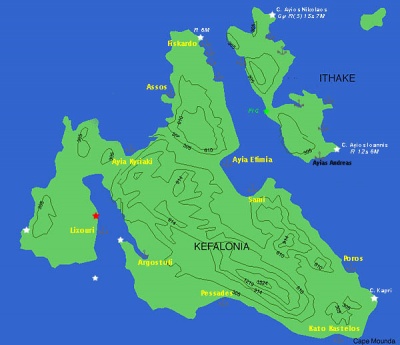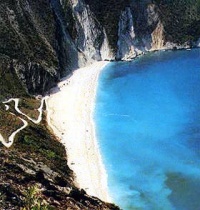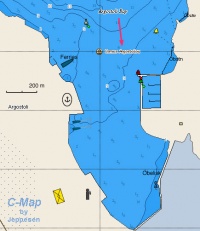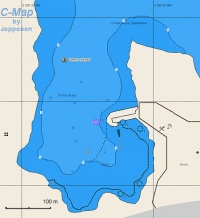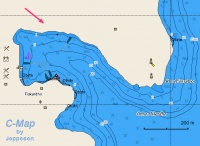Kefalonia
From CruisersWiki
Kefalonia
Background
Kefalonia (Κεφαλλονιά) or Cephalonia or Kephalonia is the largest of the Ionian islands. It is N of Zakynthos and S of Lefkas. It is separated from the smaller Itháki by a narrow channel. It is a beautiful island with many lovely beaches. It has an area of 688 km2 and its highest point, Megalo Vouno (Large Mountain), is 1.626 m above sea level.
According to mythology the island was populated by Pterelaos and his followers. Pterelaos was the son of Tarios a son of Poseidon. But soon Pterelaos was defeated by the king of Thebes Amphitryon who gave the island to his friend Cephalus. Cephalus had four sons: Kranios. Paleas, Pronnesos, and Samos. They divided the island to four city-states bearing their names. The island was most likely part of Odysseus kingdom of Ithaki.
The four city-states, Pale, Krane, Pronnos, and Same were independent and form many separate alliances with other Greek cities such as Athens and Corinth. According to Herodotus the Cephalonians stood with the Corinthians against the Persians in 474 BC. After this Persian war the island fell under the Athenian alliance but at the end of the Peloponnesian war she allied with Sparta. But the Athenians invaded the island in 373 BC and held it until 226 BC. The island successfully repulsed the invasion of Philip the Macedon.
On the 2nd century AD Kephalonia was taken over by the Romans. During Byzantine times the island was major naval base and very active in protecting the empire from its many enemies. In 1508 the Norman pirate Robert Guiscard who was king of Sicily landed in the northern cove. He eventually died there and the cove was named after his Italian name Giskardo corrupted Greek as Fiskárdo. During the Crusades the island fell under the Franks and after a treaty with the Venetians in 1204 AD the island was governed by Matthew Orsini under the overlordship of Venice. In 1324 the Naples conquered the island. In 1357 the Neapolitans ceded the island to Leonardo Toko whose family governed the island until 1479 when it was conquered by the Ottomans but the Venetians after a bloody siege took it over in 1500 and held it until 1797.
In 1797 Kephalonia along the rest of the Ionian islands was taken over by the French who were received by the locals as liberators. They governed the island as a republic and established many schools. This period was short because in the 29th of October 1798 the combined Russian and Ottoman fleets invaded the region and in 1800 they established the State of the Seven Islands. This was also short lived and in 1807 the Ionian islands were back into French hands. But in 1809 the British defeated the French and now became the new lords of the region and established the United States of the Ionian Islands. This lasted until 1864 when the Ionian islands became part of the new state of Modern Greece.
After the WW II defeat of Greece by the Germans, their Italian allies occupied the island. After the collapse of the Mussolini fascist regime the Italians surrendered to the allies and the Germans landed on the island.They rounded up the Italian division which until that time was occupying the island. They executed the lot, about 3,000 men with only very few escaping, helped by the locals. Every year on the anniversary of the massacre, the survivors and their families, accompanied by Italian and Greek dignitaries, come for a memorial service.This story is the basis of the fascinating novel Corelli's Mandolin by Louis de Bernières and the film which was shot in Kephalonia.
On August 12, 1953 there was a devastating 6.5-7 earthquake on the Ionian. The main city of the island, Argostoli, was almost totally demolished. There were large scale destruction with only the town of Fiskardo spared.
The patron saint of Kephalonia is St. Gerasimos. He is celebrated on October 20 and in August 15 in which day the islanders celebrate both the virgin Mary and one of St. Gerasimos' miracles. The following story was told to me (--Istioploos 14:29, 18 April 2008 (MDT)) my a local taxi driver:
There once was a convent by the sea which was under attack by pirates. The nuns, afraid of being captured and ravished, prayed for deliverance to St. Gerasimos. Soon, a multitude of small, 10 -15 cm, snakes appeared on the monastery grounds. The pirates, who had landed in the mean time, were bitten and scared away by the snakes and the nuns were saved. From that day until today these small snakes appear for a few days around August 15, and they are considered sacred. If they fail to appear it is considered a terrible omen. Last time that they did not appear was 1953 which was followed by the earthquakes that practically demolished Argostoli and Lixouri, the largest towns on the island.
Charts
BA 203 Nisos Zakinthos to Nisos Paxoi
BA 1557 Argostoli Port
Imray-Tetra G12 Nísos Levkas to Nísos Zákinthos
NIMA 54280 Corfu Channel to Nisis Proti
Radio Nets
Also see World Cruiser's Nets
- Coast Guard - VHF channel 12
All approaches except for the Argostoli/Lixouri are straightforward.
Danger: The entrance to the Argostoli/Lixouri is full of dangers, under no circumstances you should enter during dark.
Ports and Popular Stops
Argostoli
Argostóli (Αργοστόλι) [38° 11.2' N 20° 29.5' E] is the main harbor of Kefalonia. It was destroyed by the 1953 and has been re-build bad now it is a bustling town without much architectural character.
You drop your anchor in 4-5 m depth on mud, good holding, and back to either the N or the W quay, S of the ferry quay. Be aware that the prevailing wind here is from the N. It is also possible to anchor off in a cove NE of the harbor but now I believe there are some fish farms there.
Lixoúri
Lixoúri (Ληξούρι) [38° 12.1' N 20° 26.6' E] is the second town on the island. It is just across from Argostoli, connected by road and by ferries. The harbor is reputed to be smelly and uncomfortable.
Ayia Kyriaki
Ayia Kyriaki or Ayia Kiriaki is a lovely small harbor in NW Kephalonia.
Assos
Assos (Άσσος) or Port Assos [38° 22.8' N 20° 32.2' E] is a picturesque small harbor in NW Kephalonia dominated by a Venetian fort. It is very popular with tourists.
It is possible to anchor and take a line to the mole but it is only 1.5-2 m deep. Alternatively you can anchor off in 4-7 m depths. The holding here is not always good as the bottom has mud, weed, and shingle. There are swells with the prevailing N-NW winds.
Fiskardó
Fiskardó (Φισκαρδό) or Fiskardho or Phiscardo [38° 27.7' N 20° 34.7' E] is a charming and well sheltered small harbor on the NE of Kephalonia. The name of the town is a coruption of its Norman overload Robert Guiscard.
Because the town was not destroyed by the the 1953 earthquake it is the most architecturally picturesque town on the island and as a result tourist flock there. The small harbor is almost always crowded. Your only chance of finding a spot is to learn when the flotillas depart.
Anchor in 4-5 m over sand and backup to the S or W quay. The holding is good. In the most likely case that there is no room there are a few alternatives. You can anchor on the N side, across from the town, in 12-9 m depth and take a shore line to the rocks. The bottom here does not always provide good holding, so be careful. The other alternative is to go to one of the very attractive fjord-like coves S of Fiskardho.
In Fiskardho Mr. Makis who runs the Philoxenia agency is a retired seaman and very helpful to yachties. He listens on the VHF channel 16 and can arrange for a mechanic and other services.
Ayia Efimía
Marinas & Yacht Clubs
See each Port/Stop
Anchorages
See each Port/Stop
Offshore Islands
List Islands
Routes/Passages To/From
Popular passages/routes, timing, etc.
Tourism & things to do ashore
Also see each Port/Stop
Marine Stores & Facilities
See each Port/Stop
References & Publications
Publications, Guides, etc.
Cruiser's Friends
Contact details of "Cruiser's Friends" that can be contacted for local information or assistance.
Forum Discussions
List links to discussion threads on the Cruiser Log Forum
External Links
Links to relevant websites.
Personal Notes
Personal experiences?
.
